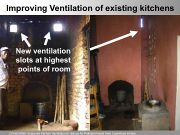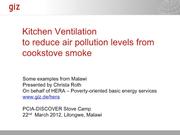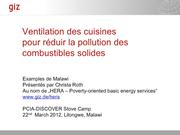Knowledge fuels change - Support energypedia!
For over 10 years, energypedia has been connecting energy experts around the world — helping them share knowledge, learn from each other, and accelerate the global energy transition.
Today, we ask for your support to keep this platform free and accessible to all.
Even a small contribution makes a big difference! If just 10–20% of our 60,000+ monthly visitors donated the equivalent of a cup of coffee — €5 — Energypedia would be fully funded for a whole year.
Is the knowledge you’ve gained through Energypedia this year worth €5 or more?
Your donation keeps the platform running, helps us create new knowledge products, and contributes directly to achieving SDG 7.
Thank you for your support, your donation, big or small, truly matters!
General Kitchen Management Practices
Cooking Energy System | Basics | Policy Advice | Planning | Designing and Implementing ICS Supply | Designing and Implementing Woodfuel Supply | Climate Change | Extra
Kitchen Management: General Cooking Energy-Saving Practices and Devices
Certain ways of fuel preparation and handling of the stove offer potentials to improve cooking efficiency to reduce the amount of fuels used for cooking and to avoid the exposure to harmful emissions. One option is that users adjust their behaviour and adopt efficient cooking practices. Another option is to integrate energy-saving devices such as pressure cookers or heat retainers into the household cooking system. Hence, an optimal kitchen ventilation allows smoke to leave the kitchen before harming the cooks. These options are described in more details in the following three sections.
Fuel-saving Cooking Practices
Simple changes in the cooking practices of households can save substantial amounts of fuel. The following guidelines, commonly known as 'kitchen management practices' can be applied to save energy while cooking:
Don't waste fuel by running an empty stove
- Get all the ingredients needed for the dish readily prepared (collecting, washing, cutting, etc.) before you start the fire.
- Have all ingredients and utensils at hand close to the stove, including cooking tools, water, and spices.
- Don't waste time once the fire is started and avoid wandering off (e.g. to chat with your neighbour) while the stove is already on.
- Extinguish the fire when you have finished cooking.
Make the best use of the heat from the fire
- Ensure that the heat generated from the fire finds its way into the pot. For instance, shield the pot from wind e.g. with a skirt around the pot to avaid the hot flue gases blown away and the coolingt of the pot by the wind.
- Use a metal pot. It conducts heat better than a clay pot.
- Use a pot with a flat bottom instead of round-shaped pots. The transfer of heat into a flat-bottom pot is higher.
- Reduce the intensity of the fire once the food has come to a boil.
- Use a heat retaining device after boiling.
- Use a lid on the pot to prevent surplus steam from escaping the pot (steam is water heated beyond boiling point, so any steam leaving the pot is energy lost for the cooking process).
- Use small amounts of water for cooking: any water that is thrown away after cooking has consumed a lot of energy until it boiled. This practice not only saves fuel but also retains nutrients.
- Clean soot of your cooking pan.
Shorten cooking times of certain foods
- Soak dried food (such as beans, peas, rice, etc.) prior to cooking.
- Cut food up into smaller pieces: e.g. cut smaller cubes or slices instead of boiling a whole potato or cassava root.
- Don't overcook food. Monitor the cooking process closely by testing regularly if the food is already cooked. Once the food is ready to eat, take it off the stove.
Often the impact of simple behavioural changes is overlooked, or is not known to the project staff or partner organisations. Since most of these practices do not require additional tools or devices, households can save energy at little or no cost.
In addition, efficient cooking practices do not only take place in the kitchen itself, but already start with fuel management.
Further Information
Efficient cooking practices based on experience from Malawi in English and French |
No cost techniques kitchen management practices
|
|
based on experience from Burkina Faso in French |
|
| Mode d'utilisation des foyers améliorés. An instruction to "good practice" and "bad practice" of the stoves for Benin. | |
| Save Our Trees-A guideline to to Saving Energy |
Kitchen Ventilation to Reduce Air Pollution Levels from Cookstove Smoke
This section deals with technologies and techniques that reduce the air pollution and smoke level within a kitchen.
Smoke exposure is influenced by various factors:
- by the fuel used, by the user behavior,
- by the type of cookstove, and
- by the ventilation.
With a 3-stone fire and no or bad ventilations, walls are often black from the floor to the roof, indicating that the kitchen used to be filled entirely with smoke. Not even chimneys are necessarily the solution for smoke removal: the smoke leaves not out of chimney, but out of door and windows. Most chimney- stoves only function well with the pot the stove was designed for, not with a kettle without lip.
If climate allows openings in the wall, simple ventilation slots at highest points of room can guide smoke out in extisting kitchens. Hence, cross-ventilation at the height of peoples nose are as well easily to install and a effective measure to lead smoke out of the kitchen. However, please remember, that ‘Clean’ cooking is not a result of the stove, but from the use of stove.
|
Improving Ventilation of existing kitchens (picture by C. Roth, GIZ) |
For more pictures and information, see presentation below:
|
References |
Links |
|---|---|
|
Kitchen Ventilation to reduce air pollution levels from cookstove smoke: Examples from Malawi. Presentation of Christa Roth, held at PCIA Discover Stove Camp, 22nd of March 2012 in Malawi (English). |
|
|
Ventilation des cuisines pour réduir la pollution des combustibles solides: Examples de Malawi presentés par Christa Roth a PCIA Discover Stove Camp, 22 March 2012 in Malawi (French). |
References
This article was originally published by GIZ HERA. It is basically based on experiences, lessons learned and information gathered by GIZ cook stove projects. You can find more information about the authors and experts of the original “Cooking Energy Compendium” in the Imprint.



























